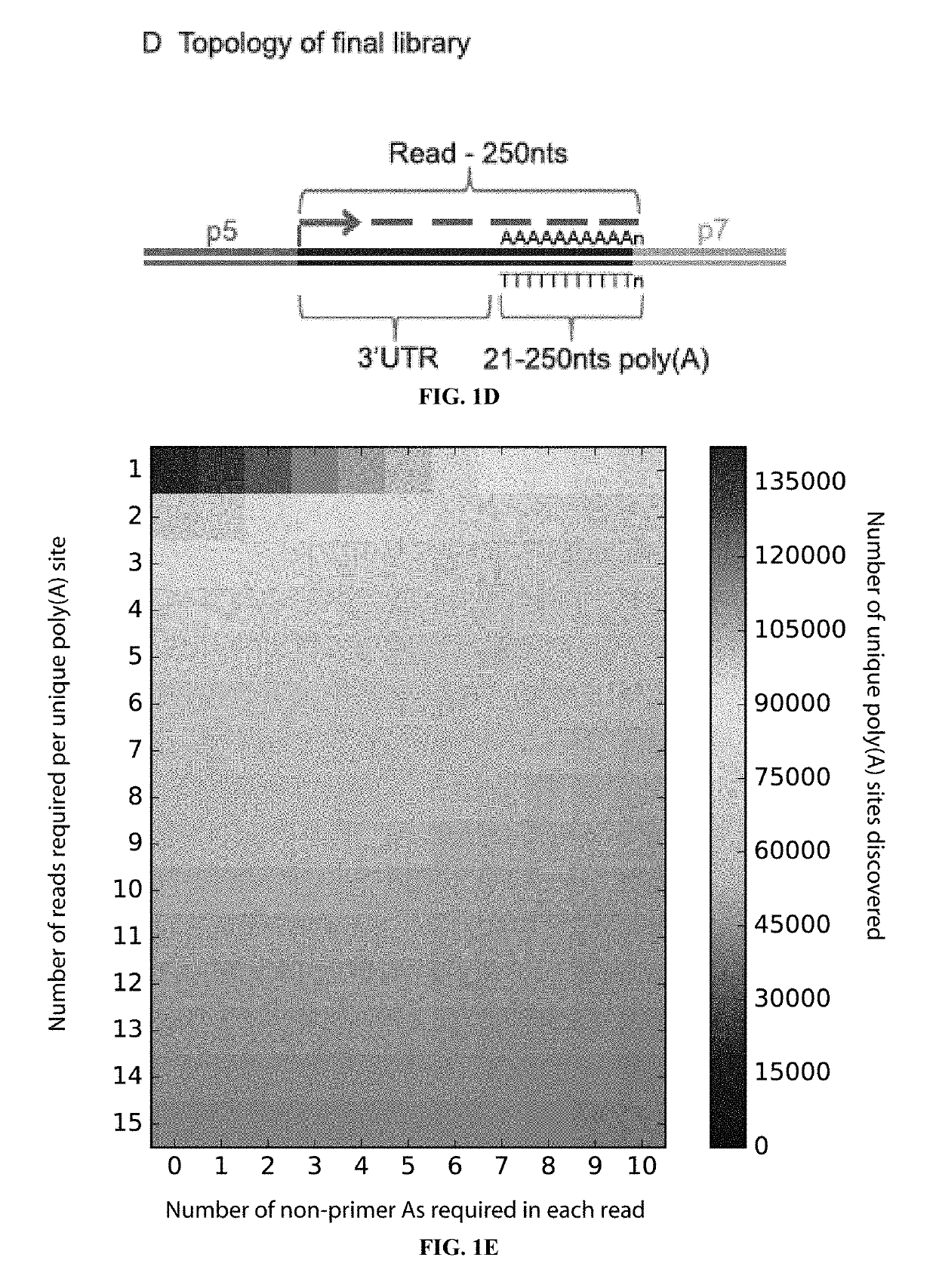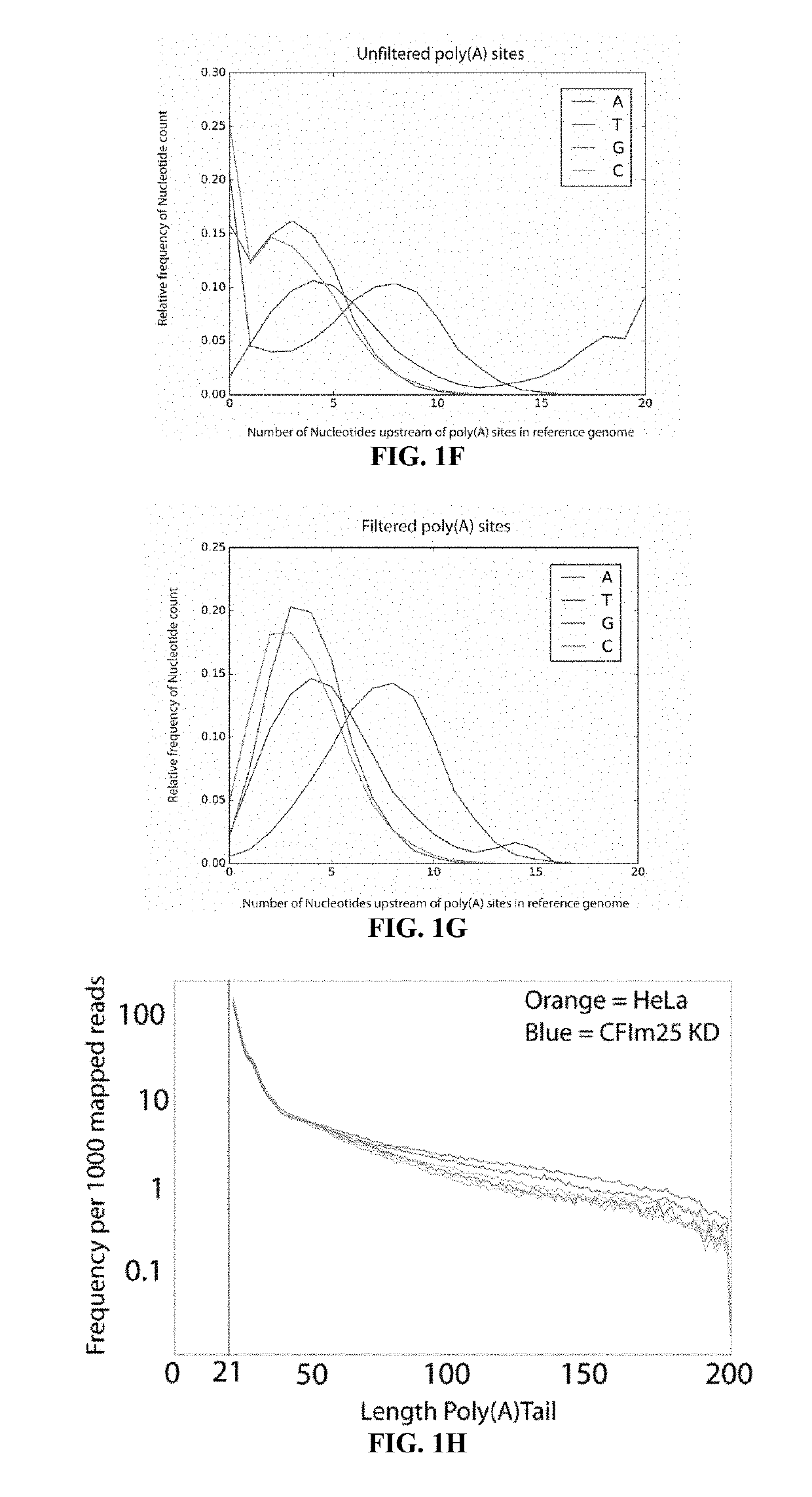Poly(A)-ClickSeq Click-Chemistry for Next Generation 3-End Sequencing Without RNA Enrichment or Fragmentation
a click-chemistry and 3′-end sequencing technology, applied in the field of next-generation sequencing, can solve the problems of reducing throughput capacity, affecting so as to reduce the occurrence of mispriming, and ensure the quality of the sampl
- Summary
- Abstract
- Description
- Claims
- Application Information
AI Technical Summary
Benefits of technology
Problems solved by technology
Method used
Image
Examples
example 1
hod to Direct the cDNA Synthesis Specifically Toward the 3′UTR / Poly(A) Tail Junction of Cellular RNA
[0036]The inventors have developed a novel method to direct the cDNA synthesis specifically toward the 3′UTR / poly(A) tail junction of cellular RNA. With this novel approach, the inventors demonstrate sensitive and specific enrichment for poly(A) site junctions without the need for complex sample preparation, fragmentation or purification. Poly(A)-ClickSeq (PAC-seq) is therefore a simple procedure that generates high-quality RNA-seq poly(A) libraries. As a proof-of-principle, the inventors utilized PAC-seq to explore the poly(A) landscape of both human and Drosophila cells in culture and observed outstanding overlap with existing poly(A) databases and also identified previously unannotated poly(A) sites. Moreover, the inventors utilize PAC-seq to quantify and analyze APA events regulated by CFIm25 illustrating how this technology can be harnessed to identify alternatively polyadenylate...
example 2
lickSeq as a Tool Enabling Simultaneous Genome-Wide Poly(A)-Site Identification and Differential Expression Analysis
[0142]The use of RNA-seq as a generalized tool to measure the differential expression of genes has essentially replaced the use of the microarray. Despite the acknowledged technical advantages to this approach, RNA-seq library preparation remains mostly conducted by core facilities rather than in the laboratory due to the infrastructure, expertise and time required per sample. Described hereinabove is the basic two ‘click-chemistry’ based library construction methods termed ClickSeq and poly(A)-click-seq (PAC-seq) as alternatives to conventional RNA-seq that are both cost effective and rely on straightforward reagents readily available to the skilled artisan. ClickSeq is random-primed and can sequence any (unfragmented) RNA template, while PAC-seq is targeted to poly(A) tails of mRNAs. This example uses the PAC-seq as a platform that allows for simultaneous mapping of ...
references — example 1
REFERENCES—EXAMPLE 1
[0210]1. Proudfoot, N. J. (2011) Ending the message: poly(A) signals then and now. Genes Dev, 25, 1770-1782.[0211]2. Kempf, B. J. and Barton, D. J. (2015) Picornavirus RNA polyadenylation by 3D(pol), the viral RNA-dependent RNA polymerase. Virus Res, 206, 3-11.[0212]3. Wilusz, J. (2013) Putting an ‘End’ to HIV mRNAs: capping and polyadenylation as potential therapeutic targets. AIDS Res Ther, 10, 31.[0213]4. Sheets, M. D., Ogg, S. C. and Wickens, M. P. (1990) Point mutations in AAUAAA and the poly (A) addition site: effects on the accuracy and efficiency of cleavage and polyadenylation in vitro. Nucleic Acids Res., 18, 5799-5805.[0214]5. Hu, J., Lutz, C. S., Wilusz, J. and Tian, B. (2005) Bioinformatic identification of candidate cis-regulatory elements involved in human mRNA polyadenylation. RNA, 11, 1485-1493.[0215]6. Xiang, K., Tong, L. and Manley, J. L. (2014) Delineating the structural blueprint of the pre-mRNA 3′-end processing machinery. Mol Cell Biol, 34,...
PUM
| Property | Measurement | Unit |
|---|---|---|
| Molar density | aaaaa | aaaaa |
| Molar density | aaaaa | aaaaa |
| Volume | aaaaa | aaaaa |
Abstract
Description
Claims
Application Information
 Login to View More
Login to View More - R&D
- Intellectual Property
- Life Sciences
- Materials
- Tech Scout
- Unparalleled Data Quality
- Higher Quality Content
- 60% Fewer Hallucinations
Browse by: Latest US Patents, China's latest patents, Technical Efficacy Thesaurus, Application Domain, Technology Topic, Popular Technical Reports.
© 2025 PatSnap. All rights reserved.Legal|Privacy policy|Modern Slavery Act Transparency Statement|Sitemap|About US| Contact US: help@patsnap.com



